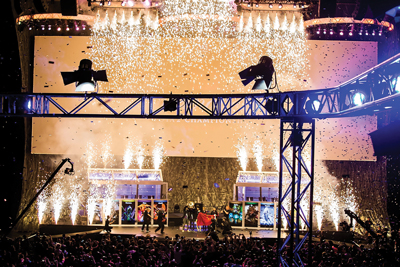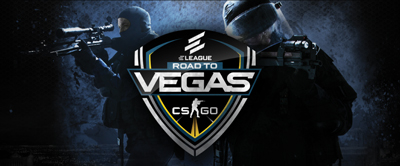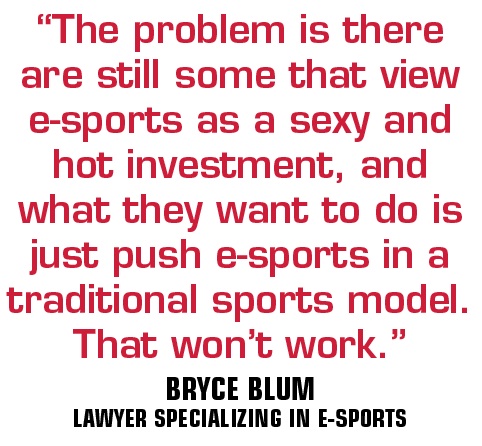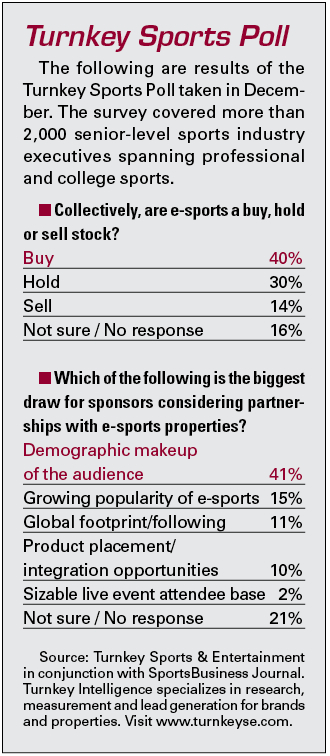Peter Moore, chief operating officer at Electronic Arts, has been closely involved in competitive video gaming for more than a decade, including successful ventures such as the annual FIFA Interactive World Cup and the Madden NFL Live Challenge, and some less so like the now-shuttered EA Sports Arena.
Each of those efforts has largely existed on a grassroots level. And in Moore’s view, e-sports needs to provide more offerings, for all age groups and skill levels. A lot more. And a lot broader.
“We want to create value all the way up the ecosystem,” Moore said. “We think this is something that can be approachable for a wide variety of audiences.”
 |
Numbers behind events such as The International tournament have produced skyrocketing activity in e-sports.
Photo by: Getty Images |
EA is creating a new e-sports division, the Competitive Gaming Division, that will be run by Moore and begin to more fully take shape later this year. The division will create competitions around key EA titles such as “FIFA,” “Madden NFL” and some of its nonsports games such as “Battlefield.” EA’s new division provides not only an e-sports component to the company’s core business of selling video game titles but also a forum to stage live events, create media content and generate sponsorship revenue.
“It is evident to us that this represents a large and important growth opportunity for the company,” Moore said. “This has the feeling of a great startup, but a startup within a $4.5 billion company with three decades of experience in gaming.”
Moore’s comments and EA’s decision to create the Competitive Gaming Division are hardly surprising. The latter half of 2015 was marked by a large and historic sweep of other activity in the burgeoning e-sports space, including:
■ Activision-Blizzard’s hiring of former ESPN and NFL executive Steve Bornstein.
■ The joint venture between Turner Broadcasting and WME-IMG to create the ELeague, which will make an initial public introduction at this week’s International Consumer Electronics Show in Las Vegas.
■ Team purchases by several high-level sports industry executives.
■ Numerous seven- and eight-figure rounds of venture capital funding into the industry.
Each of the moves seeks to take full advantage of some of the most robust, most deeply engaged and fastest-growing audiences anywhere in sports or entertainment, populated heavily by hard-to-reach millennial audiences but existing largely out of the mainstream.
But thematically similar to a beloved indie rock band making its debut on a major record label, e-sports’ elevation to the industry big leagues raises several crucial questions that will go far in defining its direction in 2016.
Will the infusion of major dollars and corporate interest compromise what made e-sports so popular in the first place? Will e-sports become something akin to Facebook, a large and successful operation that nonetheless doesn’t have the same cachet among young consumers it once did? And as e-sports gets positioned to mass, mainstream audiences, how will it be presented in a way understandable to those not already versed in video gaming?
 |
Electronic Arts has a new division that will create competitions around titles such as “FIFA” and “Battlefield.”
Photo by: Electronic Arts |
“It’s really exciting, but e-sports was something before these guys cared,” said Craig Levine, chief executive of ESL America, the domestic version of the German-based Electronic Sports League, and a 15-year veteran of e-sports.
ESL is working with Activision-Blizzard on a new league based around the popular first-person shooter title “Call of Duty.”
“E-sports needs to make sure we don’t succumb to the expectations to be something that we’re not,” Levine said.
Walking the line
Craig Barry, executive vice president of production and chief content officer at Turner Sports, and the point person for the new ELeague, is precisely one of those guys who hadn’t cared about e-sports until more recently. But now deeply ensconced in the nuances of the world of competitive gaming, he’s convinced that Turner and its partners can have their cake and eat it, too.
ELeague will have a showcase of its first “Counter-Strike: Global Offensive” championship at CES on Jan. 7, positioning itself in front of more than 150,000 technology executives, with the event also streamed live online. The basic idea is for the showcase to tease the debut of the full ELeague later in 2016.
Turner officials have not outlined the startup costs for the league, which will be supported by revenue from advertising and events.
ELeague will be fully and professionally produced with graphics, replays and commentary, not unlike how Turner shows Major League Baseball, the NBA, NCAA and PGA Tour, among other major sports properties.
And even though e-sports doesn’t have decades of history like those other leagues and most sports fans don’t know who the top e-sports players are, Barry believes many of the same tried-and-true rules of narrative and storytelling in sports broadcasting will still apply.
The ELeague production, based in part around Friday night televised showcases on TBS as well as daily coverage online and on mobile, will feature elements from NBC’s typical production of the Olympics, which provides features and personal vignettes to familiarize viewers with the individual competitors and rivalries in non-familiar sports.
“There is a great opportunity, for example, to create compelling content around individual players,” Barry said.
“Who is the LeBron James of this space? We can tell that story.”
But Barry insists ELeague will not sacrifice its authenticity, and intends to position the venture as a truly high-level
 |
| ELeague will have its coming out party at the International Consumer Electronics Show. |
forum for professional “Counter-Strike: Global Offensive” players.
“All of the core experiences of the tournaments and the gameplay will be fully authentic to what these players have come to know and expect,” Barry said. “You have to have it. The players will demand it, and we are demanding it, too. But we also can build things up around that. If we can expand the landscape, and appeal to more people, it can only be good for gaming as a whole.”
But a big part of the challenge for e-sports properties, media companies and investors during this high-growth period is that many of the foremost templates from traditional stick-and-ball sports do not apply. E-sports fills arenas, generates fervent fan passion and tons of content consumption. Beyond that, though, e-sports doesn’t have widely known players or a single pre-eminent pro league. And unlike most other traditional sports with the exception of soccer, America is far from a world power in e-sports, with Europe and particularly Asia standing as e-sports hotbeds.
“There is still a learning curve. Everybody is still figuring out how to play in this space. And it’s not necessarily a straightforward process,” said Greg Bettinelli, partner with Los Angeles venture capital firm Upfront Ventures, which invested in fantasy e-sports outfit AlphaDraft before it was bought out in September by FanDuel. Bettinelli also has personally invested in an e-sports team.
“There are a lot of companies out there who want to be the ESPN of e-sports, for example. But this audience doesn’t really watch ESPN,” Bettinelli said. “There’s also the old adage in sports that the smaller the ball, the worse the viewing audience is. E-sports doesn’t even have a ball. So that suggests the need for a different kind of content strategy, something that looks a lot more like Hulu or Netflix than ESPN.”
Growing the pie
Bryce Blum, a Seattle-based attorney, founding partner of IME Law and one of the few lawyers focusing entirely on e-sports, also is wrestling with trying to prevent investors from simply applying old industry rules to this newer and emerging space.
“The problem is there are still some that view e-sports as a sexy and hot investment, and what they want to do is just push e-sports in a traditional sports model. That won’t work,” said Blum, who has represented numerous e-sports teams, players and leagues, including e-sports betting platform Unikrn.
“There just needs to be a safeguarding of what has made e-sports, e-sports, while at the same time taking the right opportunities to grow it even further,” Blum said.
Much of that safeguarding thus far has come in the form of major media, investment and gaming outfits aligning with native e-sports companies and executives to help maintain a pure link to the space. Turner and WME-IMG are working with London-based gaming platform FACEIT. The ESL has already staged competitions around EA games including “Battlefield” and “Madden NFL,” and EA has been actively hiring game producers and other personnel with deep e-sports experience.
And Bornstein, in addition to the work with ESL, will be aided directly in building Activision-Blizzard’s new e-sports division by Senior Vice President Mike Sepso, previously the co-founder and president of 14-year-old industry property Major League Gaming.
That combination of veteran e-sports know-how with the new, large-scale media distribution and corporate dollars also could prove to be a catalyst to provide structure and clarity to what is now a highly disorganized and fragmented marketplace. E-sports is populated by a disparate series of tournaments, games, competitions and properties including those based around popular games “League of Legends” and “Dota 2.”
As of now, there is typically little to no link from one tournament to another. But many involved in the space foresee the development of a much more stratified platform somewhat akin to English soccer where there are distinct levels of competition, promotion and relegation, and a clear pathway for both individual players and teams to rise through the e-sports ranks.
“If you love e-sports and want it to be stable, then this is nothing but a good development,” said veteran e-sports journalist and commentator Rod Breslau of the incoming rush of corporate attention. “If for no other reason than teams should be able to sell more sponsorships due to the increased visibility, hopefully providing players with higher salaries and helping to build a more stable playing structure.”








